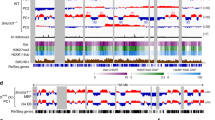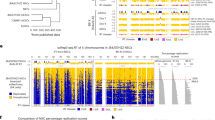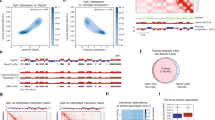Abstract
Human inactive X chromosome (Xi) forms a compact structure called the Barr body, which is enriched in repressive histone modifications such as trimethylation of histone H3 Lys9 (H3K9me3) and Lys27 (H3K27me3). These two histone marks are distributed in distinct domains, and X-inactive specific transcript (XIST) preferentially colocalizes with H3K27me3 domains. Here we show that Xi compaction requires HBiX1, a heterochromatin protein 1 (HP1)–binding protein, and structural maintenance of chromosomes hinge domain–containing protein 1 (SMCHD1), both of which are enriched throughout the Xi chromosome. HBiX1 localization to H3K9me3 and XIST-associated H3K27me3 (XIST-H3K27me3) domains was mediated through interactions with HP1 and SMCHD1, respectively. Furthermore, HBiX1 was required for SMCHD1 localization to H3K9me3 domains. Depletion of HBiX1 or SMCHD1, but not Polycomb repressive complex 2 (PRC2), resulted in Xi decompaction, similarly to XIST depletion. Thus, the molecular network involving HBiX1 and SMCHD1 links the H3K9me3 and XIST-H3K27me3 domains to organize the compact Xi structure.
This is a preview of subscription content, access via your institution
Access options
Subscribe to this journal
Receive 12 print issues and online access
$189.00 per year
only $15.75 per issue
Buy this article
- Purchase on Springer Link
- Instant access to full article PDF
Prices may be subject to local taxes which are calculated during checkout






Similar content being viewed by others
References
Heitz, E. Das Heterochromatin der Moose. Jahrb. Wiss. Bot. 69, 762–818 (1928).
Trojer, P. & Reinberg, D. Facultative heterochromatin: is there a distinctive molecular signature? Mol. Cell 28, 1–13 (2007).
Barr, M.L. & Bertram, E. A morphological distinction between neurones of the male and female, and the behaviour of the nucleolar satellite during accelerated nucleoprotein synthesis. Nature 163, 676–677 (1949).
Ohno, S., Kaplan, W.D. & Kinosita, R. Formation of the sex chromatin by a single X-chromosome in liver cells of Rattus norvegicus. Exp. Cell Res. 18, 415–418 (1959).
Rego, A., Sinclair, P.B., Tao, W., Kireev, I. & Belmont, A.S. The facultative heterochromatin of the inactive X chromosome has a distinctive condensed ultrastructure. J. Cell Sci. 121, 1119–1127 (2008).
Lyon, M.F. Gene action in the X-chromosome of the mouse (Mus musculus L.). Nature 190, 372–373 (1961).
Chow, J. & Heard, E. X inactivation and the complexities of silencing a sex chromosome. Curr. Opin. Cell Biol. 21, 359–366 (2009).
Lee, J.T. Gracefully ageing at 50, X-chromosome inactivation becomes a paradigm for RNA and chromatin control. Nat. Rev. Mol. Cell Biol. 12, 815–826 (2011).
Barakat, T.S., Jonkers, I., Monkhorst, K. & Gribnau, J. X-changing information on X inactivation. Exp. Cell Res. 316, 679–687 (2010).
Gendrel, A.-V. Smchd1-dependent and -independent pathways determine developmental dynamics of CpG island methylation on the inactive X chromosome. Dev. Cell 23, 265–279 (2012).
Peters, A.H.F.M. et al. Partitioning and plasticity of repressive histone methylation states in mammalian chromatin. Mol. Cell 12, 1577–1589 (2003).
Rens, W., Wallduck, M.S., Lovell, F.L., Ferguson-Smith, M.A. & Ferguson-Smith, A.C. Epigenetic modifications on X chromosomes in marsupial and monotreme mammals and implications for evolution of dosage compensation. Proc. Natl. Acad. Sci. USA 107, 17657–17662 (2010).
Chow, J.C. & Heard, E. Nuclear organization and dosage compensation. Cold Spring Harb. Perspect. Biol. 2, a000604 (2010).
Chadwick, B.P. & Willard, H.F. Multiple spatially distinct types of facultative heterochromatin on the human inactive X chromosome. Proc. Natl. Acad. Sci. USA 101, 17450–17455 (2004).
Coppola, G., Pinton, A., Joudrey, E.M., Basrur, P.K. & King, W.A. Spatial distribution of histone isoforms on the bovine active and inactive X chromosomes. Sex Dev. 2, 12–23 (2008).
Shevchenko, A.I., Pavlova, S.V., Dementyeva, E.V. & Zakian, S.M. Mosaic heterochromatin of the inactive X chromosome in vole Microtus rossiaemeridionalis. Mamm. Genome 20, 644–653 (2009).
Chaumeil, J. et al. Evolution from XIST-independent to XIST-controlled X–chromosome inactivation: epigenetic modifications in distantly related mammals. PLoS ONE 6, e19040 (2011).
Chadwick, B.P. Variation in Xi chromatin organization and correlation of the H3K27me3 chromatin territories to transcribed sequences by microarray analysis. Chromosoma 116, 147–157 (2007).
Maison, C. & Almouzni, G. HP1 and the dynamics of heterochromatin maintenance. Nat. Rev. Mol. Cell Biol. 5, 296–304 (2004).
Nozawa, R.-S. Human POGZ modulates dissociation of HP1α from mitotic chromosome arms through Aurora B activation. Nat. Cell Biol. 12, 719–727 (2010).
Plath, K. et al. Role of histone H3 lysine 27 methylation in X inactivation. Science 300, 131–135 (2003).
Silva, J. et al. Establishment of histone H3 methylation on the inactive X chromosome requires transient recruitment of Eed–Enx1 Polycomb group complexes. Dev. Cell 4, 481–495 (2003).
Blewitt, M.E. et al. SmcHD1, containing a structural-maintenance-of-chromosomes hinge domain, has a critical role in X inactivation. Nat. Genet. 40, 663–669 (2008).
Margueron, R. & Reinberg, D. The Polycomb complex PRC2 and its mark in life. Nature 469, 343–349 (2011).
Brown, C.J. et al. A gene from the region of the human X inactivation centre is expressed exclusively from the inactive X chromosome. Nature 349, 38–44 (1991).
Brown, C.J. et al. The human XIST gene: analysis of a 17-kb inactive X-specific RNA that contains conserved repeats and is highly localized within the nucleus. Cell 71, 527–542 (1992).
Clemson, C.M., McNeil, J.A., Willard, H.F. & Lawrence, J.B. XIST RNA paints the inactive X chromosome at interphase: evidence for a novel RNA involved in nuclear/chromosome structure. J. Cell Biol. 132, 259–275 (1996).
Teller, K. et al. A top-down analysis of Xa- and Xi-territories reveals differences of higher order structure at ≥20 Mb genomic length scales. Nucleus 2, 465–477 (2011).
Iyer, L.M., Abhiman, S. & Aravind, L. MutL homologs in restriction-modification systems and the origin of eukaryotic MORC ATPases. Biol. Direct 3, 8 (2008).
Moissiard, G. et al. MORC-family ATPases required for heterochromatin condensation and gene silencing. Science 336, 1448–1451 (2012).
Lorković, Z.J., Naumann, U., Matzke, A.J.M. & Matzke, M. Involvement of a GHKL ATPase in RNA-directed DNA methylation in Arabidopsis thaliana. Curr. Biol. 22, 933–938 (2012).
Kanno, T. et al. A structural-maintenance-of-chromosomes hinge domain–containing protein is required for RNA-directed DNA methylation. Nat. Genet. 40, 670–675 (2008).
Splinter, E. et al. The inactive X chromosome adopts a unique three-dimensional conformation that is dependent on Xist RNA. Genes Dev. 25, 1371–1383 (2011).
Csankovszki, G., Nagy, A. & Jaenisch, R. Synergism of Xist RNA, DNA methylation, and histone hypoacetylation in maintaining X chromosome inactivation. J. Cell Biol. 153, 773–784 (2001).
Csankovszki, G., Panning, B., Bates, B., Pehrson, J.R. & Jaenisch, R. Conditional deletion of Xist disrupts histone macroH2A localization but not maintenance of X inactivation. Nat. Genet. 22, 323–324 (1999).
Wutz, A. & Jaenisch, R. A shift from reversible to irreversible X inactivation is triggered during ES cell differentiation. Mol. Cell 5, 695–705 (2000).
Hiratani, I. et al. Genome-wide dynamics of replication timing revealed by in vitro models of mouse embryogenesis. Genome Res. 20, 155–169 (2010).
Heard, E. & Disteche, C.M. Dosage compensation in mammals: fine-tuning the expression of the X chromosome. Genes Dev. 20, 1848–1867 (2006).
Gilbert, D.M. et al. Space and time in the nucleus: developmental control of replication timing and chromosome architecture. Cold Spring Harb. Symp. Quant. Biol. 75, 143–153 (2010).
Ando, S., Yang, H., Nozaki, N., Okazaki, T. & Yoda, K. CENP-A, -B, and -C chromatin complex that contains the I-type α-satellite array constitutes the prekinetochore in HeLa cells. Mol. Cell Biol. 22, 2229–2241 (2002).
Hayashi-Takanaka, Y. et al. Tracking epigenetic histone modifications in single cells using Fab-based live endogenous modification labeling. Nucleic Acids Res. 39, 6475–6488 (2011).
Obuse, C. et al. A conserved Mis12 centromere complex is linked to heterochromatic HP1 and outer kinetochore protein Zwint-1. Nat. Cell Biol. 6, 1135–1141 (2004).
Kimura, H., Hayashi-Takanaka, Y., Goto, Y., Takizawa, N. & Nozaki, N. The organization of histone H3 modifications as revealed by a panel of specific monoclonal antibodies. Cell Struct. Funct. 33, 61–73 (2008).
Li, H. & Durbin, R. Fast and accurate short read alignment with Burrows-Wheeler transform. Bioinformatics 25, 1754–1760 (2009).
Li, H. et al. The Sequence Alignment/Map format and SAMtools. Bioinformatics 25, 2078–2079 (2009).
Acknowledgements
We thank I. Hiratani, J. Nakayama and D.B. Goto for comments; Y. Hayashi-Takanaka (Osaka University) for the fluorescently labeled antibodies to histones; Y. Ohkubo for cloning the XIST gene; Y. Ohkawa for advice on ChIP-seq; and E. Ono and A. Tokushima for administrative assistance. R.-S.N. was supported by the Japan Society for the Promotion of Science (JSPS) Research Fellowships for Young Scientists (09J01447). This work was supported by the Japanese Ministry of Education, Culture, Sports, Science and Technology (20114006 to C.O. and K.N.), JSPS (24370071 to C.O. and 22710180 to K.N.) and Matrix Science KK (C.O.).
Author information
Authors and Affiliations
Contributions
R.-S.N. and K.-T.I. performed most of the experiments. K.N. performed the bioinformatics analysis. S.S. operated the Illumina GAIIx. N.S. performed MS. N.N. and H.K. raised antibodies. T.S. performed northern blotting and some RNA FISH experiments. C.O. conceived the study. C.O., K.N. and H.K. wrote the manuscript.
Corresponding author
Ethics declarations
Competing interests
N. Nozaki is a founder of the MAB Institute, Inc., which produces the antibodies to H3K9me3 and H3K27me3 used in this study.
Supplementary information
Supplementary Text and Figures
Supplementary Figures 1–6, Supplementary Table 1 and Supplementary Notes 1–3 (PDF 9534 kb)
Rights and permissions
About this article
Cite this article
Nozawa, RS., Nagao, K., Igami, KT. et al. Human inactive X chromosome is compacted through a PRC2-independent SMCHD1-HBiX1 pathway. Nat Struct Mol Biol 20, 566–573 (2013). https://doi.org/10.1038/nsmb.2532
Received:
Accepted:
Published:
Issue Date:
DOI: https://doi.org/10.1038/nsmb.2532



